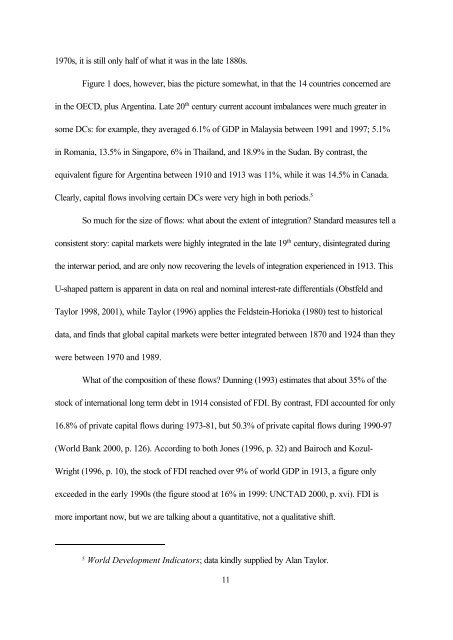Globalization and Inequality - Trinity College Dublin
Globalization and Inequality - Trinity College Dublin
Globalization and Inequality - Trinity College Dublin
You also want an ePaper? Increase the reach of your titles
YUMPU automatically turns print PDFs into web optimized ePapers that Google loves.
1970s, it is still only half of what it was in the late 1880s.<br />
Figure 1 does, however, bias the picture somewhat, in that the 14 countries concerned are<br />
in the OECD, plus Argentina. Late 20 th century current account imbalances were much greater in<br />
some DCs: for example, they averaged 6.1% of GDP in Malaysia between 1991 <strong>and</strong> 1997; 5.1%<br />
in Romania, 13.5% in Singapore, 6% in Thail<strong>and</strong>, <strong>and</strong> 18.9% in the Sudan. By contrast, the<br />
equivalent figure for Argentina between 1910 <strong>and</strong> 1913 was 11%, while it was 14.5% in Canada.<br />
Clearly, capital flows involving certain DCs were very high in both periods. 5<br />
So much for the size of flows: what about the extent of integration? St<strong>and</strong>ard measures tell a<br />
consistent story: capital markets were highly integrated in the late 19 th century, disintegrated during<br />
the interwar period, <strong>and</strong> are only now recovering the levels of integration experienced in 1913. This<br />
U-shaped pattern is apparent in data on real <strong>and</strong> nominal interest-rate differentials (Obstfeld <strong>and</strong><br />
Taylor 1998, 2001), while Taylor (1996) applies the Feldstein-Horioka (1980) test to historical<br />
data, <strong>and</strong> finds that global capital markets were better integrated between 1870 <strong>and</strong> 1924 than they<br />
were between 1970 <strong>and</strong> 1989.<br />
What of the composition of these flows? Dunning (1993) estimates that about 35% of the<br />
stock of international long term debt in 1914 consisted of FDI. By contrast, FDI accounted for only<br />
16.8% of private capital flows during 1973-81, but 50.3% of private capital flows during 1990-97<br />
(World Bank 2000, p. 126). According to both Jones (1996, p. 32) <strong>and</strong> Bairoch <strong>and</strong> Kozul-<br />
Wright (1996, p. 10), the stock of FDI reached over 9% of world GDP in 1913, a figure only<br />
exceeded in the early 1990s (the figure stood at 16% in 1999: UNCTAD 2000, p. xvi). FDI is<br />
more important now, but we are talking about a quantitative, not a qualitative shift.<br />
5<br />
World Development Indicators; data kindly supplied by Alan Taylor.<br />
11
















